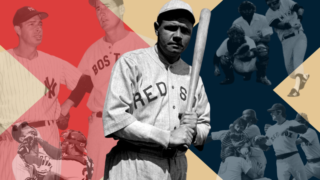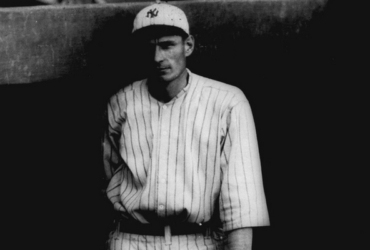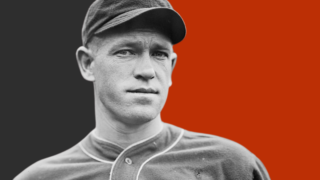Wally Pipp has been reduced to an answer to a trivia question. He’s a footnote on the career of a great player. But Pipp deserves better: he was an excellent ballplayer who happened to have a headache at the wrong time.
Pipp spent several years in professional baseball as one of the game’s best sluggers and a fine glove man at first base. He was a key member of the first Yankee team to win the World Series.
According to contemporary accounts, Pipp was a regal figure. He carried himself in a measured, graceful manner on and off the field, exhibiting a sort of grace. Remember how Steve Garvey used to walk around in a purposeful, almost official manner? Pipp was like that. It’s about the only thing Garvey and Pipp have in common.
Pipp grew up in Grand Rapids, Michigan, just as that city was becoming the furniture center of the country. Starting in the last two decades of the 19th century, tens of thousands of feet of lumber were floated into the city on the Grand River and processed to make wood furniture that was delivered to the world via the Great Lakes. Pipp’s father moved to the region to take a job in the burgeoning industry.
Just like one of the valuable Michigan pines, little Wally quickly sprouted into a tall, muscular young man. He was very smart and interested in many subjects. After completing high school, he enrolled at Catholic University in Washington D.C. where he studied architecture. He wanted to design buildings and cities. He dreamed of one day walking along streets that he had helped build.
He also enjoyed playing baseball, and at 6’2 and neatly muscled, Pipp was an impressive athlete, displaying power at the plate and finesse at first base. During his college days, in summer months he starred on the diamond for Kalamazoo in the Southern Michigan League. At the age of 19 he was clearly better than the competition in that low-level league and accepted a contract offer from the Detroit Tigers, who assigned him to Providence in the International League. Pipp pounded the pitching in that league and was promoted to Scranton in the New York State League in 1913. Detroit summoned him in the middle of the season for a quick cup of coffee.
Even as a green-behind-the-ears rookie, Pipp’s confidence drew attention. One sportswriter wrote that Pipp stood out among his teammates because he was dressed “sartorially neat in a gray suit, white shirt, and dark blue tie” on a road trip. The young first baseman was educated and curious. He acted like he wanted to do something great. Pipp’s confidence probably didn’t go over well with crusty veterans like Ty Cobb and Sam Crawford, who guarded the gate for the Detroit ball club.
In 1914, Pipp was one of the best hitters in the minor leagues, as he led the American Association in hits, triples, home runs, RBI, and slugging while playing for the Rochester (NY) Hustlers. The Tigers still owned his rights, but they had a young first baseman at the same time named “Tioga” George Burns, and they liked him very much. The Tigers sold Pipp’s contract to the New York Yankees before the 1915 season. That’s when Pipp’s baseball career took off.
You could make a lot of money in a bar bet if you asked your friends to name the first Yankee to win a home run title. It wasn’t Babe Ruth. It was Wally Pipp, who paced the league with a dozen circuit blows in 1916, his second season with the New Yorkers.
Pipp was a tall lefthanded hitter who choked up an inch or two on the bat, a long piece of wood that he had made for himself in Grand Rapids. He liked to pull the ball down the right field line where the stands were only 257 feet from home plate in the horseshoe-shaped Polo Grounds in Harlem. Because the outfield quickly jutted much farther from home plate in the power alleys, Pipp also frequently hit a lot of triples. One sportswriter noted that his greatest joy was watching Pipp “glide from the box in a counter-clockwise direction on his way to a perfect dust-flying slide into third.”
Pipp led the league in home runs again in 1917, finding fame as a slugger. As a result, he gradually inched his hands down to the nob of his bat, emulating the new method employed by Ruth and a few others. In 1920, after the famous deal that made Ruth a Yankee, Pipp was settled into the third spot in the order, directly in front of the Great Bambino.
As a Yankee, Pipp got to play in New York and view the giant skyscrapers and architecture of the great city. Walking through New York after World War I, when the city was booming with growth and an influx of immigrants, Pipp was living his dream of being in the middle of a growing metropolis. He may not have had a hand in building an actual city, but he was part of a growing sport and a team on the verge of becoming a dynasty.
It was impossible to escape the shadow of Ruth if you were his teammate. The Sultan of Swat was simply too expansive. Pipp was a fine player, one of the best first baseman in the game. He saw far more fastballs with Ruth waiting on deck behind him, and he drove in runners too, topping 100 RBI three times in the 1920s. The Yankees won the pennant in 1921, and again in 1922. The following season they moved into Yankee Stadium, and by this time Ruth was the most famous athlete in the world. In 1923 the Yankees three-peated as AL champs and finally won the World Series. Pipp was a key member of the Yankees first championship team.
Few people had ever seen someone play first base the way Pipp did. He was taller than most first basemen before him, and because he had long legs and could cover ground well, he played much deeper than previous practitioners of the position. He was able to reach for throws that smaller first basemen could not, which helped improve the effectiveness of the entire Yankee infield.
Pipp was 31 years old in 1924 when he led the league in triples and set a personal best with 110 runs batted in, but it would be his final full season as a Yankee. A muscular, impressive young ballplayer named Lou Gehrig was lurking. Seasoned right down the street at Columbia University, Gehrig was ready for the big leagues when he was 20 years old. But Pipp blocked his path, so the young first sacker spent three years cooling his heels, waiting for his chance. It came when Pipp succumbed to a familiar malady.
For his entire adult life, Pipp had been bothered by migraine headaches. The most likely culprit was a head injury he suffered while playing hockey in Michigan when he was a boy. That injury robbed him of some of his vision in his left eye, but since he was a left-handed hitter, that “trail eye” didn’t hampered him. On June 2, 1925, Pipp suffered what became the most famous headache in sports history. That day he asked the Yankee trainer for aspirin and secured a day off from manager Miller Huggins.
“We’ll let the kid play,” Huggins reportedly told Wally.
Up until that day, Gehrig had been playing about once a week in 1925. Batting sixth, Gehrig had three hits, including a double, in the Yankees 8-5 win over the Senators at Yankee Stadium. Huggins kept the rookie in the lineup the next day, and the day after that, and the day after that…and so on. Gehrig didn’t miss a game for the next 14 years.
Pipp’s transition from Yankee star to afterthought was sad and sudden. Two weeks after Gehrig replaced him in the lineup, Pipp was taking batting practice against teammate Charlie Caldwell, a rookie pitcher. One of Caldwell’s fastballs sailed up and hit Pipp in the head. Wall collapsed to to the dirt like a felled tree. He was helped from the field after suffering a severe concussion. Pipp had cloudy vision and missed six weeks. He returned in August, but Huggins used him solely as a pinch-hitter while Gehrig shined as the new first baseman. In late August, Gehrig was inserted in the cleanup spot behind Ruth for the first time. After missing that game in June with what seemed like an innocent headache, Pipp was 1-for-14 in 20 games and was finished as a Yankee.
Pipp resurfaced with the Reds and enjoyed a few more seasons playing first base in the big leagues. Cincinnati seemed a million miles away from New York, where Gehrig was establishing himself as “The Iron Horse” and forming baseball’s greatest slugging tandem with Ruth.
After his baseball career, Pipp lost money in the stock market crash and was forced to move around to find employment. In World War II he was working in Henry Ford’s famous factory at Willow Run in Ypsilanti, putting parts on bomber planes. He died in Grand Rapids at the age of 71 of a heart attack in 1965.
When he was asked about losing his starting job to Gehrig, Pipp was good-natured about it, even though it stung.
“I took the two most expensive aspirins in history,” he said.
Ever since the Yankees gave Pipp a day off and replaced him with an all-time great, a new term has joined the sports lexicon. It’s to be “Wally Pipped,” which is to lose your job after taking a day off. No athlete wants to be Wally Pipped. And Wally Pipp certainly never wanted to be, but before that incident, he had a very good career, one worth remembering for reasons other than a headache.





Thanks for a very interesting article Dan.
ROBERT – THANKS FOR READING.
You bet!
Touche. Sound arguments. Keep up the great work.
Very interesting & informative!